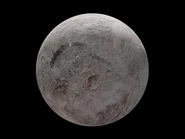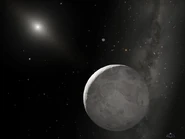Please fix this as soon as possible.
This page may cause lag to those using devices with low RAM or bad internet.
Be careful scrolling quickly, as your device may freeze or crash.
These reasons may also make editing difficult.
This page currently is 21,878 bytes in size.
Eris, official designation 136199 Eris is the fifth dwarf planet from the sun, most massive, and second-largest known dwarf planet in the Solar System. It is a trans-Neptunian object (TNO) in the scattered disk and has a high-eccentricity orbit. Eris was discovered in January 2005 by a Palomar Observatory–based team led by Mike Brown and verified later that year. In September 2006, it was named after the Greco–Roman goddess of strife and discord. Eris is the ninth-most massive known object orbiting the Sun and the sixteenth-most massive overall in the Solar System (counting moons). It is also the largest object that has not been visited by a spacecraft. Eris has been measured at 2,326 ± 12 kilometers (1,445 ± 7 mi) in diameter; its mass is 0.28% that of the Earth and 27% greater than that of Pluto, although Pluto is slightly larger by volume, both having a surface area that is comparable to the area of Russia or Antarctica.
Eris has one large known moon, Dysnomia. In February 2016, Eris's distance from the Sun was 96.3 AU (14.41 billion km; 8.95 billion mi), more than three times that of Neptune or Pluto. With the exception of long-period comets, Eris and Dysnomia were the most distant known natural objects in the Solar System until the discovery of 2018 VG18 (Farout) in 2018.
Because Eris appeared to be larger than Pluto, NASA initially described it as the Solar System's tenth planet. This, along with the prospect of other objects of similar size being discovered in the future, motivated the International Astronomical Union (IAU) to define the term planet for the first time. Under the IAU definition approved on August 24, 2006, Eris, Pluto and Ceres are "dwarf planets", reducing the number of known planets in the Solar System to eight, the same as before Pluto's discovery in 1930. Observations of a stellar occultation by Eris in 2010 showed that it was slightly smaller than Pluto, which was measured by New Horizons as having a mean diameter of 2,377 ± 4 kilometers (1,477 ± 2 mi) in July 2015.
Discovery
Eris was discovered by the team of Mike Brown, Chad Trujillo, and David Rabinowitz on January 5, 2005, from images taken on October 21, 2003. The discovery was announced on July 29, 2005, the same day as Makemake and two days after Haumea, due in part to events that would later lead to controversy about Haumea. The search team had been systematically scanning for large outer Solar System bodies for several years, and had been involved in the discovery of several other large TNOs, including Quaoar, Orcus, and Sedna. Routine observations were taken by the team on October 21, 2003, using the 1.2 m Samuel Oschin Schmidt telescope at Palomar Observatory, California, but the image of Eris was not discovered at that point due to its very slow motion across the sky: The team's automatic image-searching software excluded all objects moving at less than 1.5 arcseconds per hour to reduce the number of false positives returned. When Sedna was discovered in 2003, it was moving at 1.75 arcsec/h, and in light of that the team reanalyzed their old data with a lower limit on the angular motion, sorting through the previously excluded images by eye. In January 2005, the re-analysis revealed Eris's slow orbital motion against the background stars.
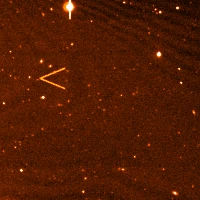
Animation showing the movement of Eris on the images used to discover it. Eris is indicated by the arrow. The three frames were taken over a period of three hours.
Follow-up observations were then carried out to make a preliminary determination of Eris's orbit, which allowed the object's distance to be estimated. The team had planned to delay announcing their discoveries of the bright objects Eris and Makemake until further observations and calculations were complete, but announced them both on July 29 when the discovery of another large TNO they had been tracking (Haumea) was controversially announced on July 27 by a different team in Spain.
Precovery images of Eris have been identified back to September 3, 1954.
More observations released in October 2005 revealed that Eris has a moon, later named Dysnomia. Observations of Dysnomia's orbit permitted scientists to determine the mass of Eris, which in June 2007 was calculated to be (1.66±0.02)×1022 kg, 27%±2% greater than Pluto's.
Name
Eris is named after the Greek goddess Eris (Greek Ἔρις), a personification of strife and discord. The name was proposed by the Caltech team on September 6, 2006, and it was assigned on September 13, 2006, following an unusually long period in which the object was known by the provisional designation 2003 UB313, which was granted automatically by the IAU under their naming protocols for minor planets.
Xena
Due to uncertainty over whether the object would be classified as a planet or a minor planet, because varying nomenclature procedures apply to these classes of objects, the decision on what to name the object had to wait until after the August 24, 2006, IAU ruling. For a time the object became known to the wider public as Xena. "Xena" was an informal name used internally by the discovery team, inspired by the title character of the television series Xena: Warrior Princess. The discovery team had reportedly saved the nickname "Xena" for the first body they discovered that was larger than Pluto. According to Brown, "We chose it since it started with an X (planet "X"), it sounds mythological ... and we've been working to get more female deities out there (e.g. Sedna). Also, at the time, the TV show was still on TV, which shows you how long we've been searching!"
Choosing an official name
According to science writer Govert Schilling, Brown initially wanted to call the object "Lila", after a concept in Hindu mythology that described the cosmos as the outcome of a game played by Brahman. The name could be pronounced like "Lilah", the name of Brown's newborn daughter. Brown was mindful of not making his name public before it had been officially accepted. He had done so with Sedna a year previously, and had been heavily criticized. However, no objection was raised to the Sedna name other than the breach of protocol, and no competing names were suggested for Sedna.
He listed the address of his personal web page announcing the discovery as /~mbrown/planetlila and in the chaos following the controversy over the discovery of Haumea, forgot to change it. Rather than needlessly anger more of his fellow astronomers, he simply said that the webpage had been named for his daughter and dropped "Lila" from consideration.
Brown had also speculated that Persephone, the wife of the god Pluto, would be a good name for the object. The name had been used several times for planets in science fiction and was popular with the public, having handily won a poll conducted by New Scientist magazine. ("Xena", despite only being a nickname, came fourth.) This choice was not possible once the object was classified as a dwarf planet (and thus minor), because there was already a minor planet with that name, 399 Persephone.
The discovery team proposed Eris on September 6, 2006. On September 13, 2006, this was accepted as the official name by the IAU. Brown decided that, because the object had been considered a planet for so long, it deserved a name from Greek or Roman mythology like the other planets. The asteroids had taken the vast majority of Graeco-Roman names. Eris, whom Brown described as his favorite goddess, had fortunately escaped inclusion. "Eris caused strife and discord by causing quarrels among people," said Brown in 2006, "and that's what this one has done too."
Classification
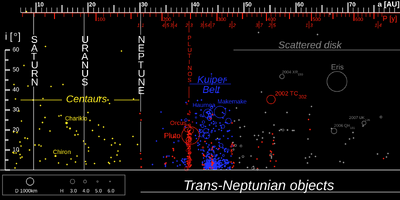
Distribution of trans-Neptunian objects
Eris is a trans-Neptunian dwarf planet. Its orbital characteristics more specifically categorize it as a scattered-disk object (SDO), or a TNO that has been "scattered" from the Kuiper belt into more-distant and unusual orbits following gravitational interactions with Neptune as the Solar System was forming. Although its high orbital inclination is unusual among the known SDOs, theoretical models suggest that objects that were originally near the inner edge of the Kuiper belt were scattered into orbits with higher inclinations than objects from the outer belt.
Because Eris was initially thought to be larger than Pluto, it was described as the "tenth planet" by NASA and in media reports of its discovery. In response to the uncertainty over its status, and because of ongoing debate over whether Pluto should be classified as a planet, the IAU delegated a group of astronomers to develop a sufficiently precise definition of the term planet to decide the issue. This was announced as the IAU's Definition of a Planet in the Solar System, adopted on August 24, 2006. At this time, both Eris and Pluto were classified as dwarf planets, a category distinct from the new definition of planet. Brown has since stated his approval of this classification. The IAU subsequently added Eris to its Minor Planet Catalogue, designating it (136199) Eris.
Orbit
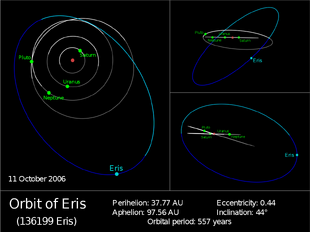
The orbit of Eris (blue) compared to those of Saturn, Uranus, Neptune, and Pluto (white/gray). The arcs below the ecliptic are plotted in darker colors, and the red dot is the Sun. The diagram on the left is a polar view whereas the diagrams on the right are different views from the ecliptic.
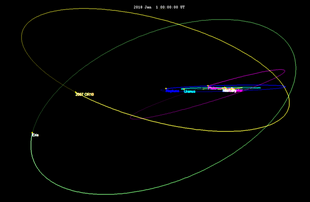
Side of the orbit of Eris along with Gonggong (2007 OR10)
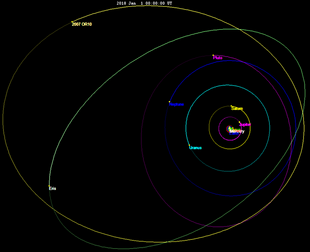
Top view of the orbit of Eris along with Gonggong (2007 OR10)
Eris has an orbital period of 559 years. Its maximum possible distance from the Sun (aphelion) is 97.5 AU, and its closest (perihelion) is 38 AU. As the time of perihelion is defined at the epoch chosen using an unperturbed two-body solution, the further the epoch is from the date of perihelion, the less accurate the result. Numerical integration is required to predict the time of perihelion accurately. Numerical integration by JPL Horizons shows that Eris came to perihelion around 1699, to aphelion around 1977, and will return to perihelion around December 2257. Unlike those of the eight planets, whose orbits all lie roughly in the same plane as the Earth's, Eris's orbit is highly inclined: it is tilted at an angle of about 44 degrees to the ecliptic. When discovered, Eris and its moon were the most distant known objects in the Solar System, apart from long-period comets and space probes. It retained this distinction until the discovery of 2018 VG18 (Farout) in 2018.
As of 2008, there were approximately forty known TNOs, most notably 2006 SQ372, 2000 OO67 and Sedna, that are currently closer to the Sun than Eris, even although their semi-major axis is larger than that of Eris (67.8 AU).
The Eridian orbit is highly eccentric, and brings Eris to within 37.9 AU of the Sun, a typical perihelion for scattered objects. This is within the orbit of Pluto, but still safe from direct interaction with Neptune (~37 AU). Pluto, on the other hand, like other plutinos, follows a less inclined and less eccentric orbit and, protected by orbital resonance, can cross Neptune's orbit. In about 800 years, Eris will be closer to the Sun than Pluto for some time.
As of 2007, Eris has an apparent magnitude of 18.7, making it bright enough to be detectable to some amateur telescopes. A 200-millimeter (7.9 in) telescope with a CCD can detect Eris under favorable conditions. The reason it had not been noticed until now is its steep orbital inclination; searches for large outer Solar System objects tend to concentrate on the ecliptic plane, where most bodies are found.
Because of the high inclination of its orbit, Eris passes through only a few constellations of the traditional Zodiac; it is now in the constellation Cetus. It was in Sculptor from 1876 until 1929 and Phoenix from roughly 1840 until 1875. In 2036 it will enter Pisces and stay there until 2065, when it will enter Aries. It will then move into the northern sky, entering Perseus in 2128 and Camelopardalis (where it will reach its northernmost declination) in 2173.
Rotation
Eris displays very little variation in brightness as it rotates due to its uniform surface, making measurement of its rotation period difficult. Precise long-term monitoring of Eris's brightness indicates that it is tidally locked to its moon Dysnomia, with a rotation period synchronous with the moon's orbital period of 15.78 Earth days. Dysnomia is also tidally locked to Eris, which makes the Eris–Dysnomia system the second known case of double-synchronous rotation, after Pluto and Charon. Previous measurements of Eris's rotation period obtained highly uncertain values ranging tens of hours to several days due to insufficient long-term coverage of Eris's rotation. The axial tilt of Eris has not been measured, but it can be reasonably assumed that it is the same as Dysnomia's orbital inclination, which would be about 78 degrees with respect to the ecliptic. If this were the case, most of Eris's northern hemisphere would be illuminated by sunlight, with 30% of the hemisphere experiencing constant illumination in 2018.
Size, mass and density
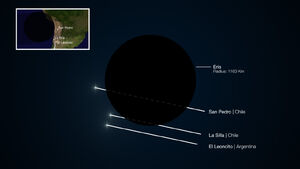
Illustration of the stellar occultation by Eris in November 2010. The resulting occultation chords project a circular silhouette for Eris, giving a spherical diameter of 2,326 km (1,445 mi)

Size comparison: Eris (lower left) with the Moon and Earth (top and right)
In November 2010, Eris was the subject of one of the most distant stellar occultations yet from Earth. Preliminary data from this event cast doubt on previous size estimates. The teams announced their final results from the occultation in October 2011, with an estimated diameter of 2326±12 km. This makes Eris a little smaller than Pluto by area and diameter, which is 2372±4 km across, although Eris is more massive. It also indicates a geometric albedo of 0.96. It is speculated that the high albedo is due to the surface ices being replenished because of temperature fluctuations as Eris's eccentric orbit takes it closer and farther from the Sun.
The mass of Eris can be calculated with much greater precision. Based on the accepted value for Dysnomia's period at the time—15.774 days—Eris is 27% more massive than Pluto. Using the 2011 occultation results, Eris has a density of 2.52±0.07 g/cm3, substantially denser than Pluto, and thus must be composed largely of rocky materials.
Models of internal heating via radioactive decay suggest that Eris could have an internal ocean of liquid water at the mantle–core boundary.
In July 2015, after nearly a decade of Eris being thought to be the ninth-largest known object to directly orbit the Sun, close-up imagery from the New Horizons mission determined the volume of Pluto to be slightly larger than that of Eris. Eris is now understood to be the tenth-largest known object to directly orbit the sun by volume, but remains the ninth-largest by mass.
Surface and atmosphere
The discovery team followed up their initial identification of Eris with spectroscopic observations made at the 8 m Gemini North Telescope in Hawaii on January 25, 2005. Infrared light from the object revealed the presence of methane ice, indicating that the surface may be similar to that of Pluto, which at the time was the only TNO known to have surface methane, and of Neptune's moon Triton, which also has methane on its surface.
Due to the distant and eccentric orbit of Eris, its surface temperature is estimated to vary from about 30 to 56 K (−243.2 to −217.2 °C; −405.7 to −358.9 °F).
Unlike the somewhat reddish Pluto and Triton, Eris appears almost white. Pluto's reddish color is thought to be due to deposits of tholins on its surface, and where these deposits darken the surface, the lower albedo leads to higher temperatures and the evaporation of methane deposits. In contrast, Eris is far enough from the Sun that methane can condense onto its surface even where the albedo is low. The condensation of methane uniformly over the surface reduces any albedo contrasts and would cover up any deposits of red tholins.
Even though Eris can be up to three times farther from the Sun than Pluto, it approaches close enough that some of the ices on the surface might warm enough to sublime. Because methane is highly volatile, its presence shows either that Eris has always resided in the distant reaches of the Solar System, where it is cold enough for methane ice to persist, or that the celestial body has an internal source of methane to replenish gas that escapes from its atmosphere. This contrasts with observations of another discovered TNO, Haumea, which reveal the presence of water ice but not methane.
Satellite
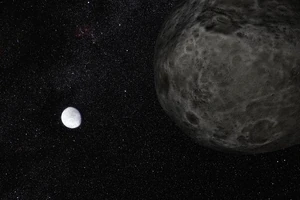
Artist's conception of Eris and its dark moon Dysnomia
In 2005, the adaptive optics team at the Keck telescopes in Hawaii carried out observations of the four brightest TNOs (Pluto, Makemake, Haumea, and Eris), using the newly commissioned laser guide star adaptive optics system. Images taken on September 10 revealed a moon in orbit around Eris. In keeping with the "Xena" nickname already in use for Eris, Brown's team nicknamed the moon "Gabrielle", after the television warrior princess's sidekick. When Eris received its official name from the IAU, the moon received the name Dysnomia, after the Greek goddess of lawlessness who was Eris's daughter. Brown says he picked it for similarity to his wife's name, Diane. The name also retains an oblique reference to Eris's old informal name Xena, portrayed on television by Lucy Lawless, though the connection was unintentional.
| Eridian system | ||||
|---|---|---|---|---|
| Name | Diameter (km) | Semi-major axis
(km) |
Mass
(1022 kg) |
Discovery date |
| Eris | 2326±12 | >1.6 | January 5, 2005 | |
| Dysnomia | ≈ 600 km (≤ 740 km) | 37 273±64 | <0.05 | September 10, 2005 |
Exploration
Eris was observed from afar by the outbound New Horizons spacecraft in May 2020, as part of its extended mission following its successful Pluto flyby in 2015. Although Eris was farther from New Horizons (112 AU) than it was from Earth (96 AU), the spacecraft's unique vantage point inside the Kuiper belt permitted observations of Eris at high phase angles that are otherwise unobtainable from Earth, enabling the determination of the light scattering properties and phase curve behavior of the Eridian surface.
In the 2010s, there were multiple studies for follow-on missions to explore the Kuiper belt, among which Eris was evaluated as a candidate. It was calculated that a flyby mission to Eris would take 24.66 years using a Jupiter gravity-assist, based on launch dates of April 3, 2032, or April 7, 2044. Eris would be 92.03 or 90.19 AU from the Sun when the spacecraft arrives.
| The Planets and Dwarf Planets | |
|---|---|
| Planets | |
| Mercury • Venus • Earth • Mars • Jupiter • Saturn • Uranus • Neptune | |
| Dwarf Planets | |
| Ceres • Pluto • Haumea • Makemake • Quaoar • Eris | |




